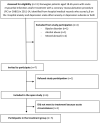The Attention Training Technique Reduces Anxiety and Depression in Patients With Coronary Heart Disease: A Pilot Feasibility Study
- PMID: 35967654
- PMCID: PMC9363691
- DOI: 10.3389/fpsyg.2022.948081
The Attention Training Technique Reduces Anxiety and Depression in Patients With Coronary Heart Disease: A Pilot Feasibility Study
Abstract
Background and objectives: Depression and anxiety symptoms are highly prevalent in coronary heart disease (CHD) patients and associated with poor outcome. Most psychological treatments have shown limited effectiveness on anxiety and depression in these patients. This study evaluates the feasibility of the attention training technique (ATT) in CHD patients with symptoms of anxiety and/or depression.
Methods: Five consecutive CHD patients with significant depression and anxiety symptoms with Hospital Anxiety and Depression rating scale (HADS) -anxiety or -depression subscale score > 8 received 6 weekly group-sessions of ATT in an open trial. Outcomes included feasibility and symptoms measured by HADS, at baseline, post-treatment and at 6 months follow-up. We also assessed psychiatric diagnoses, type D personality, insomnia, worry, and rumination.
Results: The sample comprised five men with a mean age of 59.9 (SD 4.4) years. Four of the patients attended all six sessions, and one patient attended all but one session. Mean HADS-A scores at baseline, post-treatment, and follow-up were 9.4 (SD 3.0), 4.2 (SD 3.0), and 4.0 (SD 2.5), and for HADS-D 8.6 (SD 3.3), 3.0 (SD 3.7), and 1.6 (SD 1.5), respectively. The results showed clinically significant changes in anxiety, depression, psychiatric disorders, insomnia, worry, and rumination. Statistically significant changes were found from pre- to post-treatment scores for HADS-A and worry, which were maintained at follow-up, and HADS-D scores significantly decreased from pre-treatment to 6-months follow-up.
Conclusions: ATT in a group format appears to be a feasible stand-alone metacognitive treatment for CHD patients. An adequately powered randomized controlled trial is warranted.
Keywords: anxiety; attention training technique; coronary heart disease; depression; metacognitive therapy.
Copyright © 2022 Dammen, Tunheim, Munkhaugen and Papageorgiou.
Conflict of interest statement
The authors declare that the research was conducted in the absence of any commercial or financial relationships that could be construed as a potential conflict of interest.
Similar articles
-
Attention training technique delivered in groups as treatment for anxiety and depression in patients with coronary heart disease: study protocol for a waiting-list randomized controlled trial.Front Psychol. 2023 Sep 18;14:1226539. doi: 10.3389/fpsyg.2023.1226539. eCollection 2023. Front Psychol. 2023. PMID: 37790218 Free PMC article.
-
Worry and rumination predict insomnia in patients with coronary heart disease: a cross-sectional study with long-term follow-up.J Clin Sleep Med. 2022 Mar 1;18(3):779-787. doi: 10.5664/jcsm.9712. J Clin Sleep Med. 2022. PMID: 34633284 Free PMC article.
-
Acceptance and commitment therapy for older people with treatment-resistant generalised anxiety disorder: the FACTOID feasibility study.Health Technol Assess. 2021 Sep;25(54):1-150. doi: 10.3310/hta25540. Health Technol Assess. 2021. PMID: 34542399 Clinical Trial.
-
Effectiveness of Metacognitive Therapy in Patients With Depression and Comorbid Anxiety Symptoms: A Case Series From India.Cureus. 2022 Apr 18;14(4):e24229. doi: 10.7759/cureus.24229. eCollection 2022 Apr. Cureus. 2022. PMID: 35602823 Free PMC article.
-
Adjuvant therapy with antidepressants for the management of inflammatory bowel disease.Cochrane Database Syst Rev. 2019 Apr 12;4(4):CD012680. doi: 10.1002/14651858.CD012680.pub2. Cochrane Database Syst Rev. 2019. PMID: 30977111 Free PMC article.
Cited by
-
Attention training technique delivered in groups as treatment for anxiety and depression in patients with coronary heart disease: study protocol for a waiting-list randomized controlled trial.Front Psychol. 2023 Sep 18;14:1226539. doi: 10.3389/fpsyg.2023.1226539. eCollection 2023. Front Psychol. 2023. PMID: 37790218 Free PMC article.
-
Risk of recurrent cardiovascular events in coronary artery disease patients with Type D personality.Front Psychol. 2023 Mar 28;14:1119146. doi: 10.3389/fpsyg.2023.1119146. eCollection 2023. Front Psychol. 2023. PMID: 37057178 Free PMC article.
-
Experiences of the attention training technique delivered in groups as treatment for anxiety and depression in patients with coronary heart disease: a qualitative study.BMC Psychiatry. 2025 Jun 3;25(1):573. doi: 10.1186/s12888-025-07027-4. BMC Psychiatry. 2025. PMID: 40461992 Free PMC article. Clinical Trial.
-
Post-stroke Depressive Symptoms and Cognitive Performances: A Network Analysis.Arch Phys Med Rehabil. 2024 May;105(5):892-900. doi: 10.1016/j.apmr.2023.10.006. Epub 2023 Oct 24. Arch Phys Med Rehabil. 2024. PMID: 37884084 Free PMC article.
-
Improving mental well-being in psychocardiology-a feasibility trial for a non-blended web application as a brief metacognitive-based intervention in cardiovascular disease patients.Front Psychiatry. 2023 Sep 28;14:1138475. doi: 10.3389/fpsyt.2023.1138475. eCollection 2023. Front Psychiatry. 2023. PMID: 37840797 Free PMC article.
References
-
- Cohen J. (1988). Statistical Power Analysis for the Behavioral Sciences, 2nd Edn. Hillsdale, NJ: Lawrence Erlbaum Associates Publishers.
LinkOut - more resources
Full Text Sources


